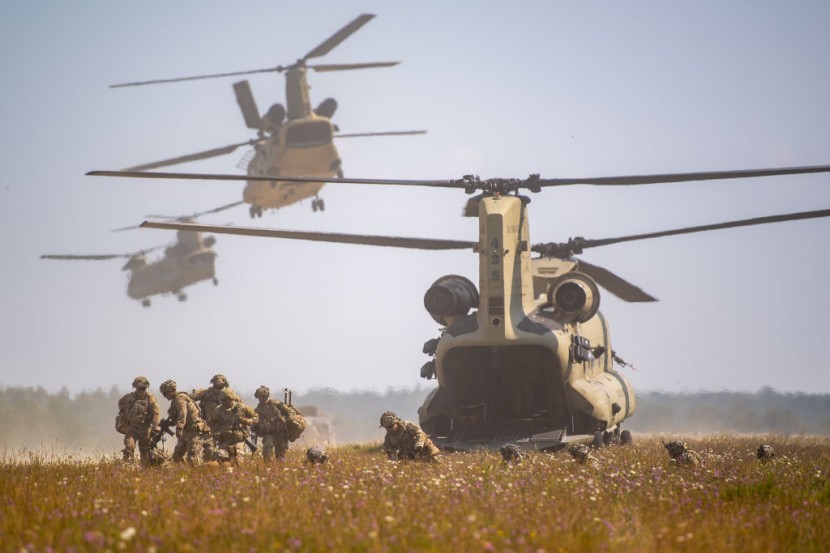
Worldwide military spending hit an all-time high of nearly $2 trillion in 2021, one international study revealed.
According to the Stockholm International Peace Research Institute (SIPRI), total military spending increased 0.7 percent from the previous year to USD2.113 trillion.
The report indicated that the worldwide military load, or global military spending as a percentage of global GDP, decreased by 0.1 percentage point from 2.3 percent in 2020 to 2.2 percent in 2021.
SIPRI identified the United States, China, India, the United Kingdom, and Russia as the top five spenders in 2021, accounting for 62% of total spending.
In 2021, global military spending increased again, hitting an all-time high of $2.1 trillion. This was the seventh year in a row that expenditure rose, per Bloomberg.
Military Spending Jump Despite COVID-19 Pandemic's Impact On Global Economy
According to Dr. Diego Lopes da Silva, Senior Researcher with SIPRI's Military Expenditure and Arms Production Programme, the military spending of nations has jumped to record levels despite the "economic fallout" brought by the COVID-19 pandemic.
'There was a slowdown in the rate of real-terms growth due to inflation. In nominal terms, however, military spending grew by 6.1 %' Dr. da Silva remarked.
The global military burden-world military expenditure as a proportion of global gross domestic product (GDP)-fell by 0.1 percentage points in 2021 as a result of a fast economic rebound, from 2.3 % to 2.2 percent %in 2021.
The SIPRI study identified the United States and China accounted for 52 % of all spending.
China's spending increased for the 27th year in a row to $293 billion, while Russia's spending increased for the third year in a row in 2021.
Who were the 5 largest military spenders in 2021?
— SIPRI (@SIPRIorg) April 24, 2022
1) USA🇺🇸
2) China🇨🇳
3) India🇮🇳
4) UK🇬🇧
5) Russia🇷🇺
Together they accounted for 62% of world military
spending. New SIPRI data out now ➡️ https://t.co/9dsFAulApR pic.twitter.com/7mP3Yfo6gh
While the United States spent significantly more on defense than any other country in 2021, it did so at a lower rate than previous years. The drop was partly attributable to a drop in overall US investment, as per SIPRI.
Alexandra Marksteiner, a researcher with SIPRI's Military Expenditure and Arms Production Program, explained that the US government has become more focused on developing next-generation technologies,
Russia, which invaded Ukraine on February 24, increased its spending by 2.9 percent to $65.9 billion, marking the third year of uninterrupted rise.
According to Dr. Lopes da Silva, Russia's defense spending accounted for 4.1 percent of GDP, far more than the world average, and made Moscow the world's fifth-biggest spender, as per an Al Jazeera report.
When Russia annexed Crimea in 2014, it was hit with sanctions at the same time as energy prices were falling, evaluate how impactful sanctions were on their own.
Ukraine's military expenditure, on the other hand, has increased by 72 % since the invasion of Crimea. Even though spending fell by more than 8% to $5.9 billion in 2021, it still accounted for 3.2 percent of the country's GDP.
EU Military Spending Increases
In 2021, total military spending in Europe amounted to $418 billion, up 3% from 2020 and 19% from 2012.
After the UK and France, Germany ranked third and spent $56 billion on its military in 2021, accounting for 1.3 percent of its GDP, according to a report from DW.
Asia and Oceania saw a 3.5 percent increase in spending, Europe saw a 3% increase, while Africa saw a 1.2 percent increase.
Spending fell by -3.3 % in the Middle East and -1.2 % in the Americas.
Iran's military budget climbed for the first time in four years, exceeding $24.6 billion, making it one of the most remarkable rises in military expenditure. In comparison to 2020, funding for the Islamic Revolutionary Guard Corps increased by 14%.
Related Article : US Air Force Area 52 Top Secret Revealed: Advanced Technology Tests for Nukes, Bombs and Other Practical Real-World Military Applications
© 2025 HNGN, All rights reserved. Do not reproduce without permission.








